Polymer Alchemy
When two or more different polymers are bonded together, structures such as cylinders or sheets can form in the material. The specific structure that is created depends on the properties of each polymer or “block,” such as its length. Now researchers have proposed a way to directly alter the structure using polymers made of three distinct blocks, in which the chemical and physical properties of the middle block can be rapidly altered using light. This polymer “alchemy” could be used to control the structures that form in this system and create previously unattainable ones.
De-Wen Sun and Marcus Müller at the University of Göttingen, Germany, simulated an ACB “triblock” polymer where the chemistry of the middle C block can be changed with light, switching the block from being miscible with the B end to being miscible with the A end. Starting with a B-miscible C block, they first allow the polymer to self-assemble into its equilibrium structure and then start tinkering. Changing the chemistry of the C block to make it miscible with the A end alters the free energy of the material. The polymers start to jiggle around, reassembling into some new metastable structure. For example, when the blocks have a length ratio of roughly 1:4, the shorter A block forms spheres, arranged on a body-centered cubic lattice, within a B-C matrix. But after a complete C block “alchemic” transformation, this structure reverses to an intricate pattern of B spheres in an A-C matrix, one that has not been observed before in polymer systems. The team predicts several other new polymer structures, extending the templating capabilities of these materials.
This research is published in Physical Review Letters.
–Katherine Wright
Katherine Wright is a Contributing Editor for Physics.





